Explainer
- Explainer
- Animals
‘Avian architecture’: Why birds’ nests are truly grand designs
Some are cup-shaped, some have domes, others have been likened to apartment complexes. How do birds build their nurseries?
It’s 1768, and James Cook’s ship Endeavour sails into the harbour of Rio de Janeiro, the capital of the Portuguese state of Brazil, to a frosty reception. The viceroy of Brazil, suspicious that Britain wants to extend its influence, doesn’t allow the crew ashore. “He certainly did not believe a word,” wrote Cook, “about our being bound to the Southward to Observe the transit of Venus but look’d upon it only as an invented story to cover some other design we must be upon”.
Naturalist Joseph Banks ignores the viceroy’s order anyway, and at midnight, a group of his men steal out through a cabin window and row ashore. “My eyes were feasted with the pleasing prospects that opened to my view on every hand,” recounted botanical artist Sydney Parkinson. Banks even decides to visit for a day himself. His offsider, scientist Daniel Solander, meanwhile, poses as a surgeon’s mate and ventures inland in search of plants and insects.
At some point, they collect a hummingbird nest. The nest, just six centimetres high, is in the fork of two branches, camouflaged with lichen, lined with fluffy seeds and woven with cobwebs – an item unique to the “New World”, which they covertly bring back to their ship. At the end of their voyage, they return to London with a haul of thousands of specimens from five lands, including Tahiti, New Zealand and New Holland (later known as Australia).
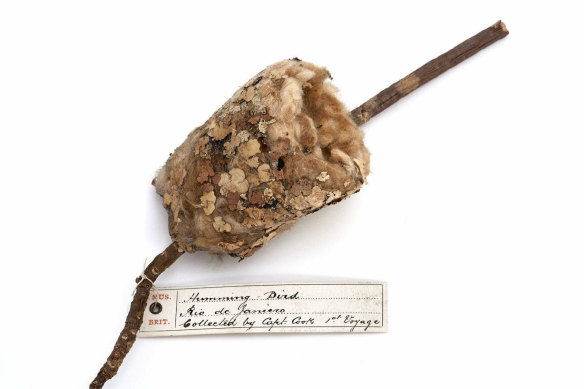
The hummingbird nest from Cook’s voyage. Credit: Trustees of London Natural History Museum
Over the years, the nest, now thought to have been that of a glittering-bellied emerald hummingbird, becomes a prized display back in England. Today, it is in London’s Natural History Museum, the oldest piece in a collection of more than 5000 bird nests. “That nest is a small encapsulation of the environment of Rio de Janeiro in 1768,” says Douglas Russell, the museum’s curator of nests and eggs and author of the Smithsonian Handbook of Interesting Bird Nests and Eggs. The cup-shaped structure is, put simply, a feat of engineering that has held together for 250 years. “We see this as avian architecture,” says Russell.
There are about 10,000 bird species worldwide and possibly as many nest variations. Yet despite this abundance, scientists are still untangling how birds build their nurseries. Some are open cups, some have roofs and hang in a teardrop shape from branches, others seem like twiggy piles. They can be found on the ground, in waterside grasslands, on cliffsides or in the nooks and crannies of buildings, such as the celebrity peregrine falcons whose chicks recently hatched on the side of an office tower in Melbourne.
For all of their sturdiness, nests and the lives they nurture are vulnerable – to predators, weather and humans. Even so, birds get resourceful with their surroundings to create structures that border on artistry. How do they do it? What’s behind the different designs? And what should you do if you come across one?
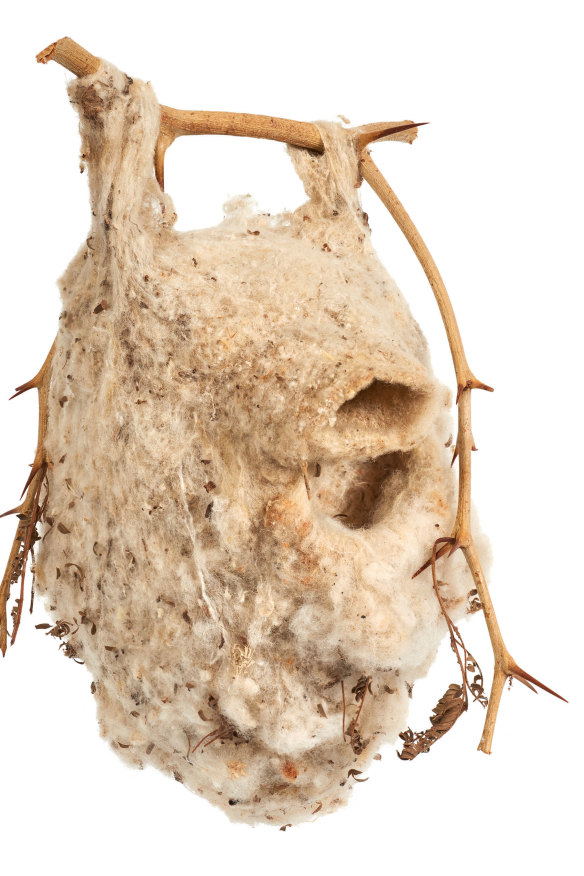
The nest of a Cape Penduline tit. Credit: Trustees of London Natural History Museum
How did nest-building evolve?
Journey into the evolution of birds, and an ancient riddle pops up: what came first, the chicken or the egg? It was once thought religion had settled the matter. In 1600, natural historian Ulisse Aldrovandi got the question out of the way quickly in his tome Aldrovandi on Chickens: “It is stated in the sacred books that the hen existed first,” he wrote. Today, it’s generally agreed that eggs predate birds. Dinosaurs laid the earliest known shelled eggs some 195 million years ago. Birds evolved later, from feathered dinosaurs called theropods, including velociraptors (which were much smaller and fluffier than the scary beasts depicted in Jurassic Park). (Pterodactyls, which did fly, are from a different lineage and had fuzz, not feathers, says David Watson, an ecology professor at Charles Sturt University.)
Australian mallee fowl build huge mounds in which to warm their eggs.
Dinosaur egg fossils are relatively common, but nests – if dinosaurs went to the trouble of constructing them – haven’t been preserved. We know that many dinosaurs buried their eggs to keep them warm, but some brooded (sat or lay) on their eggs. In 2021, in a rare discovery, scientists in China found the 70-million-year-old bones of an ostrich-like theropod squatting on top of 24 eggs, seven of which contained the bones of unhatched chicks.
Scientists believe that bird nests probably started as just a scrape on the ground. “We think they went from nothing, to cup-shaped, and some with domes. Several birds also lost domes, and then they’ve got them again,” says Susan Healy, a bird behaviour specialist at Scotland’s University of St Andrews.
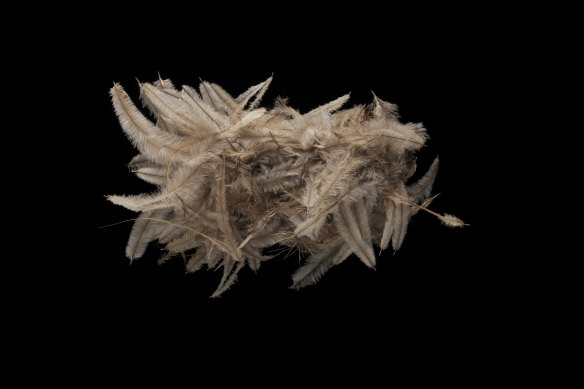
A striped honeyeater nest found in Milparinka in NSW.Credit: David Paul, Museums Victoria
Even today, not all birds build nests. Male emperor penguins keep the egg of their partner in a pouch for just over two months. Australian mallee fowl build huge mounds in which to warm their eggs. But for the most part, nests are the incubator of choice for almost all species, with at least one parent sitting on the eggs to maintain a temperature of between 36 and 40 degrees to allow the embryos inside to develop.
The other reason birds build nests is to raise their young. In general, “precocial” species such as ducks and chickens build nests on the ground, possibly because the birds hatch with their eyes open, able to walk straight away, and covered in down. Most birds are “altricial”: the chicks are unable to leave the nest for weeks while at least one parent protects and feeds them. These birds generally nest in trees to avoid predators and stay off the chillier ground.
Some altricial birds build rudimentary nests – pigeons are legendary for making flimsy, apparently slapdash constructions with just a few twigs. But most, says Iliana Medina Guzman, an ecology researcher from the University of Melbourne, make “more complex and protective nests” than precocial birds.
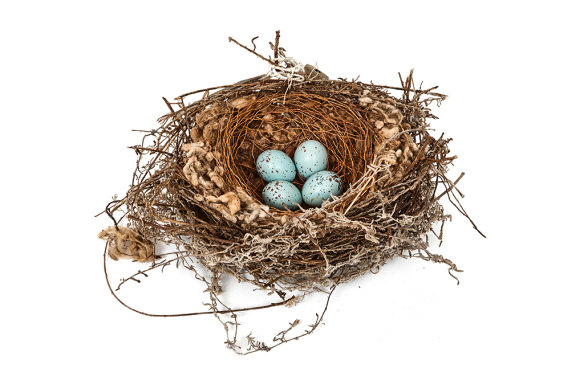
A bokmakierie nest from the London Natural History Museum’s collection of 5000 nests. Credit: Trustees of London Natural History Museum
Why the different designs?
Among the biggest nests are those of the wedge-tailed eagle, which erects a raft-like platform spanning several metres and weighing up to 400 kilograms. The bee hummingbird makes the smallest nest, about the size of a thimble. “They lay two eggs, and they’re not the size of garden peas; they’re the size of petit pois,” says Susan Healy.
What we think of as the typical nest is a cup-shaped basket. Among the London Natural History Museum’s nests, Douglas Russell points to the South African bokmakierie nest as the “ultimate expression” of this cup form: rigid sticks for the outside walls, fluffy seed material as a layer of insulation and softer grasses or twigs to pad the interior. “Those different layers are conveying different properties,” he says. “You’re looking to have a finer layer inside where there is nothing that can potentially damage the egg itself. It all comes down to the egg. You want to construct something that aids incubation.”
Climate plays an important role in the design. Guzman has found that birds build deeper cup shapes in locations with higher wind speeds to block the chill and thinner walls to ensure drainage in places prone to rainfall. Russell says the loose configuration of sticks of the bokmakierie nest helps water drain. “It’s absolutely critical that in the rains, you don’t have a waterlogged nest,” he says, “because your egg then drowns.”
‘If a snake comes and tries to get into that false entrance, it won’t find one and move on.’
One of the most noticeable differences in nest architecture is the presence, or not, of a roof. Nests with roofs, also called domed nests, typically hang from trees, usually with an entrance on the side or a tunnel dangling below. The enclosed structure is widely thought to prevent predation from snakes, cats, foxes, rats and even other birds. South Africa’s cape penduline tit builds a pear-shaped felt enclosure that hangs from a branch like a bag. From the outside, a cavity appears to be the entrance, but the actual door is a few centimetres above and can be stuck down. “From an evolutionary perspective, that is amazing,” says Russell. “If a snake comes and tries to get into that false entrance, it won’t find one and move on.”
Enclosed nests are common in Australia: fairy-wrens, thornbills and lyrebirds all make them. Guzman, who has studied hundreds of nests, thinks the roofs are mostly to do with climate. “Exposure to the sun, once the parents leave the nest, could raise the temperature of the eggs, and they could die.”
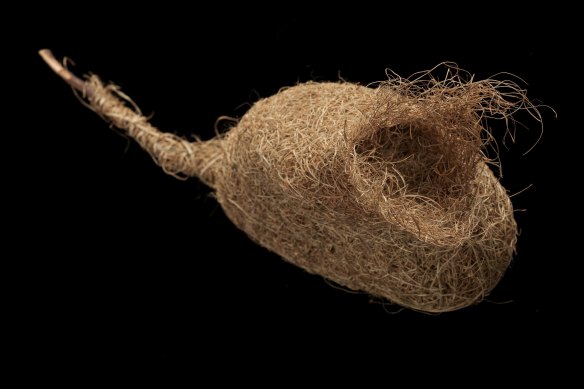
A baya weaver nest from Pune in India.Credit: David Paul, Museums Victoria
Another design difference is that some birds nest in colonies. The village weaver has among up to 150 neighbours, each in a nest hanging from the same cluster of trees. The sociable weaver, on the other hand, builds a kind of apartment complex in a tree: vast interconnected nests that look like haystacks, housing up to 300 birds. In Australia, fairy martins (also known as cliff swallows) build in smaller colonies of a dozen or so. The nests are made from mud and, with their rounded entries, appear like small pots or tubes of coral.
Recycling is not new to birds. Rather than build from scratch, some use existing cavities. Male kookaburras will burrow out a hollow in a tree. “Then it must meet the standards of the female,” says Gisela Kaplan, a professor of animal behaviour at the University of New England. “I’ve seen a case where the female was dissatisfied with the nest, and he chuckled in real annoyance but had no choice but to find another one. She didn’t like her second one either. So he had to dig three nests before she agreed.”
Many species of Australian kingfisher (and about a quarter of kingfishers worldwide) repurpose termite mounds. The termites, realising the bird isn’t a predator, will seal off the compartment once the bird settles in to nest. “Australian birds have been innovative and have been guided by what materials are available,” says Kaplan. “They use opportunities where they arise.”
Bird nests have inspired human designs, too. Crow’s nests have been a feature on sailing ships since ancient times. Beijing’s National Stadium was nicknamed the “Bird’s Nest” (a lucky symbol in China) before it had left the drawing board, say its Swiss architects, although its bowl shape references ancient Chinese objects. The exterior of a treetop cabin at a hotel in northern Sweden is built to appear like a bird’s nest. The designer, Bertil Harström, writes that he chose a “child’s perspective” to come up with the creation. As for replicating the handiwork of birds, David Watson, the ecology professor, doubts he’d be successful: “I would struggle to make nests as well and efficiently as a bird does with just stuff it finds lying around using its face. I find that pretty remarkable.”
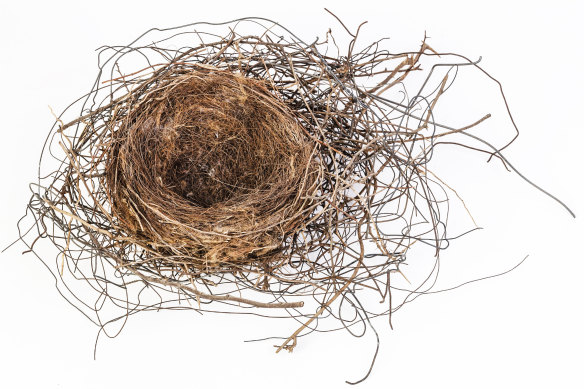
A magpie nest found in Victoria. Credit: Rodney Start, Museums Victoria
How do birds actually build their nests?
The designs of birds’ nests are, perhaps unsurprisingly, clever and often complex. Birds generally build in spring, when lengthening daylight hours signal a surge in plant growth (building materials) and insects (baby food). The nest site is chosen carefully, down to finding a suitable branch. In Australia, a yellow robin will look for a perfect vertical V; the willie wagtail builds only on flat forks; some honeyeaters seek out leafy twigs to dangle their nest from, like an open purse.
Compared to the mountain of studies on breeding, egg laying, brooding, hatching and fledging chicks, nest-building techniques have been under-scrutinised. Different species have distinctive techniques: sticking together, moulding, piling up, interlocking, sewing and weaving, wrote Mike Hansell in Bird Nests and Construction Behaviour in 2000. “The purpose of all these techniques is essentially two-fold: to ensure that the nest stays attached to the nest site and that the components of which it is made do not fall apart.”
The edible-nest swiftlet of South-East Asia has glands under the tongue that produce a gum that hardens like resin.
There are a few main ways birds stick nests together. Some, such as Australian willie wagtails, fly through spider webs that adhere to their beaks. “Arthropod silk is incredibly important to birds,” says Douglas Russell. Another is by using their own saliva: the edible-nest swiftlet of South-East Asia has glands under the tongue that produce a gum that hardens like resin. (The nests themselves are a fine-dining delicacy in Asia, historically referred to as the “caviar of the East”, and can sell for thousands of dollars per kilogram. Chefs typically boil them into a “bird’s nest soup” that is traditionally thought to have medicinal qualities.)
Birds such as Australia’s magpie lark mix mud through the sticks, bark and straw they form the nest with. The bird moulds the mud into shape before it hardens like plaster and sticks the nest to the branch. Says Gisela Kaplan: “Mud is like clay, only softer; if they don’t get the consistency right, it would mean in the design that the nest would eventually fail and break off.” Swallows can be seen shaking their heads after gathering a mouthful of mud to mix the saliva with it.
As for piling up, physicists looking at the structural dynamics of nests have hypothesised that they are, in essence, “disordered stick bombs” (non-exploding, of course) with enough energy stored in the pile to keep them rigid. Susan Healy has seen birds such as blue tits in Scotland make complex choices about their materials. The female blue tit builds alone, mostly in the warmer afternoons, over about six weeks. The bird uses its beak to first form a mound of moss and grass as a base before adding walls.
What surprised Healy most was that 20 per cent of the trips the birds make from the nest are to discard material they have collected, a possible sign they refine the pile as they build. And, contrary to the idea that birds add softer material as one layer, Healy found the blue tits weave it in as they go. “They put it all the way through; a bit like putting your wall beams up and putting the insulation in before you do anything else.”
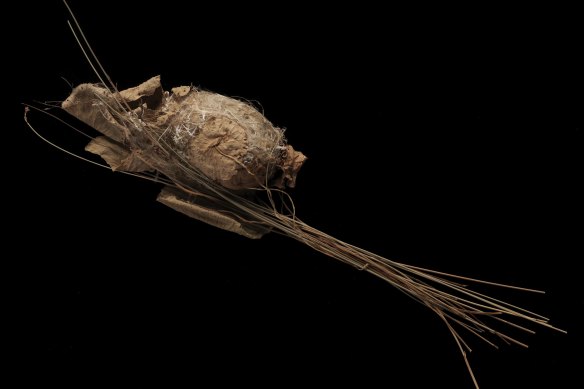
The nest of a golden-headed cisticola found in subruban Dee Why, Sydney.Credit: David Paul, Museums Victoria
Whether it’s the male or female who builds the nest is known for a quarter of the world’s birds. Of those, the main builder is usually the female, and sometimes both sexes build together, but it’s rarely only the male. The best-known exceptions are male weaver birds who build to attract a mate. They famously construct enclosed woven baskets, in some breeds making multiple nests in one tree for the female to choose from.
‘They take a piece, and they’ll put it through, and they’ll pull it around ... It looks like somebody who’s sewing.’
Healy has also observed the African southern masked weaver building its nest: he first cleans a branch of moss or loose bark, and ties several pieces of grass from it so they dangle as strands. Then he hangs upside down and ties those stands into a ring, using his foot to hold strands in place as he ties knots. This forms a frame, says Healy, to which he returns with more grass, which he begins to weave into the frame. “They take a piece, and they’ll put it through, and they’ll pull it around, and then push it through. It looks like somebody who’s sewing.”
Occasionally, the weaver’s nest plummets mid-build to the ground, or they pull it down themselves. “Somehow, something is telling them something is not right, and they have to undo what they’re doing,” says Healy. It’s long been thought birds have an innate survival drive to build nests. But Healy has shown they also learn from prior success. In 2015, she gave zebra finches in a lab some floppy string to build a nest with, then a stiffer string that was easier to use. When given the choice next time, the birds went for the stiffer material. “They associate success with what they did.”

Remnants of the nest of an African echo parakeet, bred back from the brink of extinction. Credit: Trustees of London Natural History Museum
What should you do if you find a nest?
Hobbyists and children would once collect nests and eggs, but the practice is mostly frowned upon today. In most Australian states, it is illegal to interfere with bird nests containing eggs or young without a permit. “For our research, we’ve got permits to collect from a specific place and specific nests. But only ever after the babies fledge,” says Guzman.
Even if the nest is vacant, experts say it’s best people don’t touch them. Sometimes, other birds will use parts of it to construct their own or simply move in – falcons, for example, wait until birds such as magpies have finished with their nests before raising their own chicks there. Common sense should inform if an empty nest can be moved from a tree that needs trimming, says Watson. “In many council areas I’ve worked with, they often do a lot of their tree maintenance activities in winter when nothing’s nesting, just to avoid those issues.”
Birds often choose to nest in urban areas as a strategy to avoid predators. Some, such as magpies, crows, and mynas have “basically taken over cities”, says Dominique Potvin, a behavioural ecologist at the University of Sunshine Coast. In 2022, a myna bird hung long strands of grass from a traffic light in North Sydney’s business district, blocking the red signal. Transport NSW installed metal gates and spikes but, undeterred, the bird pushed through them and built several more nests.
Human material has long been easy pickings for nesting birds. Potvin has compared about 200 nests kept by Australian museums and science institutions ranging between the 1830s and 2018. Through every decade, she found they contained at least some material made by humans – 39 per cent of the nests studied. “Before 1950, the major sources of human materials were newspapers,” she says. “There were also a lot of threads, so things like twine or cotton.” And from the 1950s, they increasingly contain plastic.
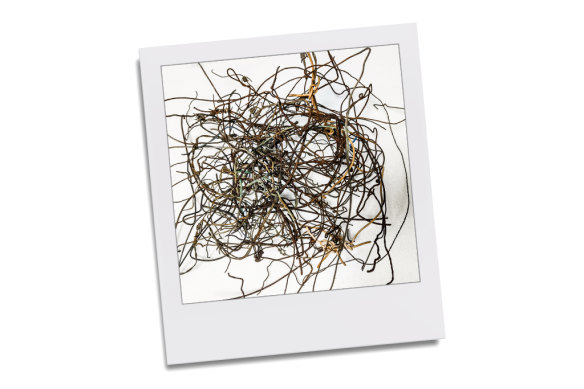
Dominique Potvin’s snap of a magpie nest made of barbed wire.Credit: Dominque Petkov
One magpie nest found in Melbourne’s south-east had metal and wire plastic coathangers, electrical wires, chicken wire, 3D glasses, metal springs, a phone charger, a Champagne cork, dental floss, headphones, baling twine and a saw blade. “It was kind of a monstrosity,” says Potvin. There were some creature comforts: “Chicken wire and clothes hangers are probably not the most comfortable thing to sit in as a baby magpie, so it had tissue paper and that sort of stuff in the middle.”
Douglas Russell has taken to collecting nests in harsh urban locations in Britain. “My predecessors would have collected song thrush nests and blackbird nests at the end of the season,” he says. “I’m collecting nests in wall-mounted cigarette bins because it’s a terrible example of the type of nesting habitat that we are providing birds.”
It’s not just habitat loss but climate change that puts birds at risk. In Australia, 163 bird species and subspecies are listed as threatened, of which 17 are critically endangered (Australia has about 1270 bird species). For scientists, carefully collecting nests might one day help save a threatened species.
“We see nests as a record of behaviour,” says Russell. The museum items most significant to him are nondescript trays with remnants of nests collected when species were nearing extinction. One is the Liben lark of Africa, one of the world’s oldest species of larks: “If it’s not already lost, it’ll be lost this year or next year,” he says. Another is the echo parakeet of Mauritius, an island nation off East Africa, collected in 1987 when there were about 10 birds left. “They managed to take some birds into captive breeding, and they really started studying the nest ecology. It was those combined efforts of field study combined with captive breeding which saved them.”
These “nests” might not appear like much, he says, yet he sees the hope of new life in them. “I don’t see a bland, uninteresting tray of wood chips. I see the beginning of a journey to save the echo parakeet.”
Get fascinating insights and explanations on the world’s most perplexing topics. Sign up for our weekly Explainer newsletter.
Let us explain
If you'd like some expert background on an issue or a news event, drop us a line at explainers@smh.com.au or explainers@theage.com.au. Read more explainers here.